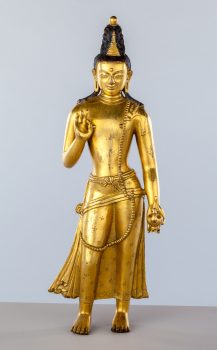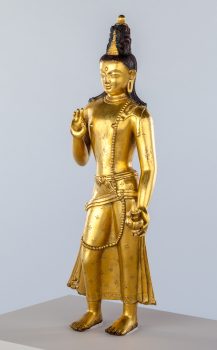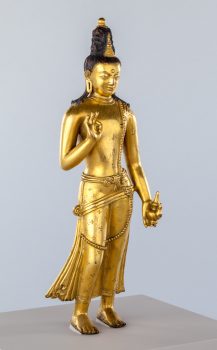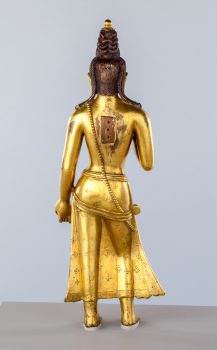Mongolia
late 18th - early 19th century




Mongolia
late 18th - early 19th century




Maitreya, the Buddha of the Future, recognizable by the stupa in his hair, is a special focus of worship among the Mongols. The promise of the coming of a new age, which the Buddha of the Future would usher in, was especially appealing to them, and they linked this story with their aspirations to reestablish the glory days of the Mongol Empire. The focus of the annual Maitreya Festival procession in Urga (present-day Ulaanbaatar) was a statue of Maitreya made by the great sculptor Zanabazar (1635–1723), a public object of veneration that would have been well known to Mongolian artists. This graceful sculpture closely follows Zanabazar’s Nepalese-inspired Maitreya compositions, characterized by a soft sleekness of form broken by a subtle asymmetrical linear pattern of cords and sashes. The gentile contrapposto pose accentuated by the flare of the hem of his clinging drapery, the tiny antelope skin draped over his left shoulder, and the unusually tall pile of hair to accommodate the stupa on his head are all hallmarks of Zanabazar’s design.
In Buddhism time is perceived as relative, dynamic, and conceptual. This outlook highlights important principles of interdependence within Buddhist philosophy.
A virtuous feeling and deep respect toward an authentic teaching, teacher, or path. Buddhists believe that expansive study, analysis, and meditation are essential steps for cultivating a healthy and enduring devotion.
An awakened being who understands the true nature of reality and is free from the cycle of birth, death, and rebirth. While there are many buddhas, Siddhartha Gautama is the historical Buddha, whose teachings became the foundation of Buddhism.
Mongolians have been widely active in the Tibetan Buddhist world, playing a key role in Tibetan culture, politics, and relations with China. In the 13th century, the Mongol Empire—the largest contiguous empire in world history—facilitated the spread of Tibetan visual culture.
Get the latest news and stories from the Rubin, plus occasional information on how to support our work.